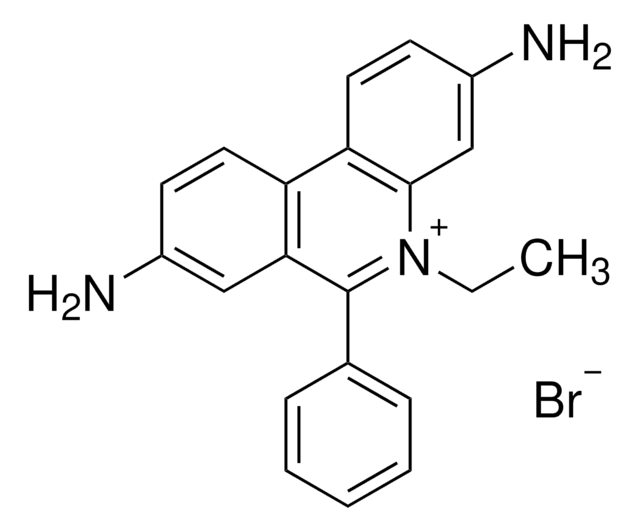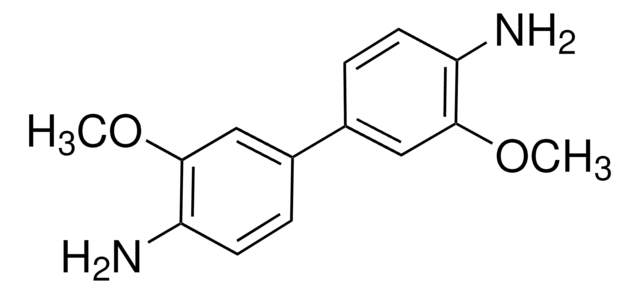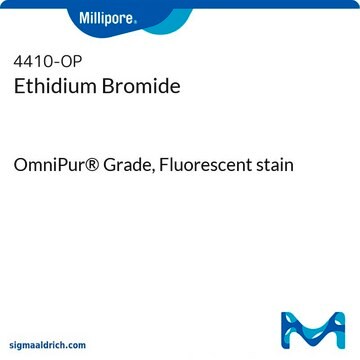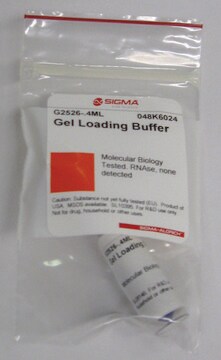E1510
Ethidiumbromid -Lösung
BioReagent, for molecular biology, 10 mg/mL in H2O
Synonym(e):
3,8-Diamino-5-ethyl-6-phenyl-phenanthridiniumbromid, EtBr, Homidiumbromid
About This Item
Empfohlene Produkte
Qualität
for molecular biology
Qualitätsniveau
Produktlinie
BioReagent
Konzentration
10 mg/mL in H2O
Methode(n)
electrophoresis: suitable
Eignung
suitable for gel electrophoresis
SMILES String
[Br-].CC[n+]1c(-c2ccccc2)c3cc(N)ccc3c4ccc(N)cc14
InChI
1S/C21H19N3.BrH/c1-2-24-20-13-16(23)9-11-18(20)17-10-8-15(22)12-19(17)21(24)14-6-4-3-5-7-14;/h3-13,23H,2,22H2,1H3;1H
InChIKey
ZMMJGEGLRURXTF-UHFFFAOYSA-N
Suchen Sie nach ähnlichen Produkten? Aufrufen Leitfaden zum Produktvergleich
Anwendung
- als Farbstoff zur Visualisierung von U937-Zellen zur Beurteilung der Zelllebensfähigkeit
- zum Nachweis von Polymerase-Kettenreaktionsprodukten
- in auf Agarose-Gelelektrophorese basierenden Gel-Verzögerungs-Assays
Biochem./physiol. Wirkung
Rekonstituierung
Ähnliches Produkt
Signalwort
Danger
H-Sätze
Gefahreneinstufungen
Acute Tox. 3 Inhalation - Muta. 2
Lagerklassenschlüssel
6.1D - Non-combustible acute toxic Cat.3 / toxic hazardous materials or hazardous materials causing chronic effects
WGK
nwg
Flammpunkt (°F)
Not applicable
Flammpunkt (°C)
Not applicable
Analysenzertifikate (COA)
Suchen Sie nach Analysenzertifikate (COA), indem Sie die Lot-/Chargennummer des Produkts eingeben. Lot- und Chargennummern sind auf dem Produktetikett hinter den Wörtern ‘Lot’ oder ‘Batch’ (Lot oder Charge) zu finden.
Besitzen Sie dieses Produkt bereits?
In der Dokumentenbibliothek finden Sie die Dokumentation zu den Produkten, die Sie kürzlich erworben haben.
Kunden haben sich ebenfalls angesehen
Protokolle
The CRISPR (Clustered Regularly Interspaced Short Palindromic Repeats) system was discovered in bacteria, where it functions as an adaptive immune system against invading viral and plasmid DNA.
The GenElute Blood Genomic DNA Kit Protocol provides a simple and convenient way to isolate pure genomic DNA from fresh or aged whole blood.
Das Protokoll für das GenElute-Aufreinigungskit für genomische Säugetier-DNA beschreibt die Isolation von reiner DNA mit hoher Molekülmasse aus verschiedenen Säugetierquellen.
GenElute Bacterial Genomic DNA Kit protocol describes a simple and convenient way for the isolation of pure genomic DNA from bacteria.
Verwandter Inhalt
Ethidiumbromid ist ein bekannter und verbreitet eingesetzter fluoreszierender Farbstoff für die biotechnologische Forschung.
Unser Team von Wissenschaftlern verfügt über Erfahrung in allen Forschungsbereichen einschließlich Life Science, Materialwissenschaften, chemischer Synthese, Chromatographie, Analytik und vielen mehr..
Setzen Sie sich mit dem technischen Dienst in Verbindung.








